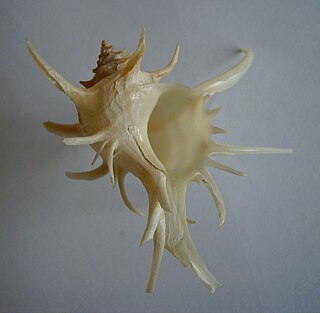
Chitons are marine molluscs of varying size in the class Polyplacophora, formerly known as Amphineura. About 940 extant and 430 fossil species are recognized.

The gumboot chiton, also known as the giant western fiery chiton or giant Pacific chiton, is the largest of the chitons, growing to 36 cm (14 in) and capable of reaching a weight of more than 2 kg (4.4 lb). It is found along the shores of the northern Pacific Ocean from Central California to Alaska, across the Aleutian Islands to the Kamchatka Peninsula and south to Japan. It inhabits the lower intertidal and subtidal zones of rocky coastlines. The gumboot chiton's appearance has led some tidepoolers to refer to it, fondly, as the "wandering meatloaf". The name "gumboot chiton" seems to derive from a resemblance to part of a rubber Wellington boot or "gum rubber" boot.

Poirieria is a genus of large predatory sea snails, marine gastropod molluscs in the subfamily Pagodulinae of the family Muricidae, the rock snails.

Eudoxochiton nobilis, commonly called the noble chiton, is a large chiton of the family Callochitonidae. The Māori name is Rangitīra.

Chiton is a genus of chitons, a polyplacophoran mollusk in the family Chitonidae.

Chiton glaucus, common name the green chiton or the blue green chiton, is a species of chiton, a marine polyplacophoran mollusk in the family Chitonidae, the typical chitons. It is the most common chiton species in New Zealand. Chiton glaucus is part of a very primitive group of mollusc with evidence of being present in up to 80 million years of the fossil record.

Tanea zelandica, common name the necklace shell or the New Zealand moon snail, is a species of medium-sized sea snail, a predatory marine gastropod mollusc in the Family Naticidae, the moon snails or necklace shells.

Buccinulum pertinax is a species of marine gastropod mollusc in the family Tudiclidae. It was first described by Eduard von Martens in 1878. It is endemic to the waters of New Zealand.

Acanthopleura granulata, common name the West Indian fuzzy chiton, is a medium-sized tropical species of chiton. This type of chiton's activity does not depend on spring-neap oscillations leading to lower locomotion loss. Its morphology is different from usual chitons as it has a fifth valve, which is split into halves.

Acanthochitonidae is a family of marine mollusks belonging to the class Polyplacophora, commonly known as chitons. Species are widely distributed throughout the world's oceans, but are most commonly found in the shallow waters of the Pacific Ocean, from Alaska to Chile.

Plaxiphora albida, the white Plaxiphora chiton, is a species of chiton in the family Mopaliidae.

Plaxiphora tricolor is a species of chiton in the family Mopaliidae.
Marjorie Katherine Mestayer was a New Zealand curator and conchologist. She is best known for the molluscan, foraminiferal and ostracod species named after her. Beginning as an amateur shell enthusiast, she went on to work as a conchology curator for the Dominion Museum in Wellington. She also received grants for her conchology research. She donated scientific and personal collections to the Museum of New Zealand Te Papa Tongarewa.
Neoguraleus manukauensis is a species of sea snail, a marine gastropod mollusk in the family Mangeliidae.

Acanthochitona crinita is a species of marine chiton in the family Acanthochitonidae. It is found on rocky coasts in the northeastern Atlantic Ocean, the North Sea and the Mediterranean Sea.

Eatoniella atervisceralis is a species of marine gastropod mollusc in the family Eatoniellidae. It was first described by Winston F. Ponder in 1965. It is endemic to the waters of New Zealand.

Eatoniella globosa is a species of marine gastropod mollusc in the family Eatoniellidae. It was first described by Winston F. Ponder in 1965. It is endemic to the waters of New Zealand.

Eatoniella latebricola is a species of marine gastropod mollusc in the family Eatoniellidae. It was first described by Winston F. Ponder in 1965. It is endemic to the waters of New Zealand.
Margaret S. Morley, was a New Zealand malacologist, illustrator and museum curator. A self-trained researcher, Morley joined the Auckland Shell Club in 1980 and became one of the leading experts in the identification of New Zealand micromollusc species. A prolific researcher, Morley published over 119 papers, most of which featured her own illustrations, and in 2004 published A Photographic Guide to Seashells of New Zealand.
















